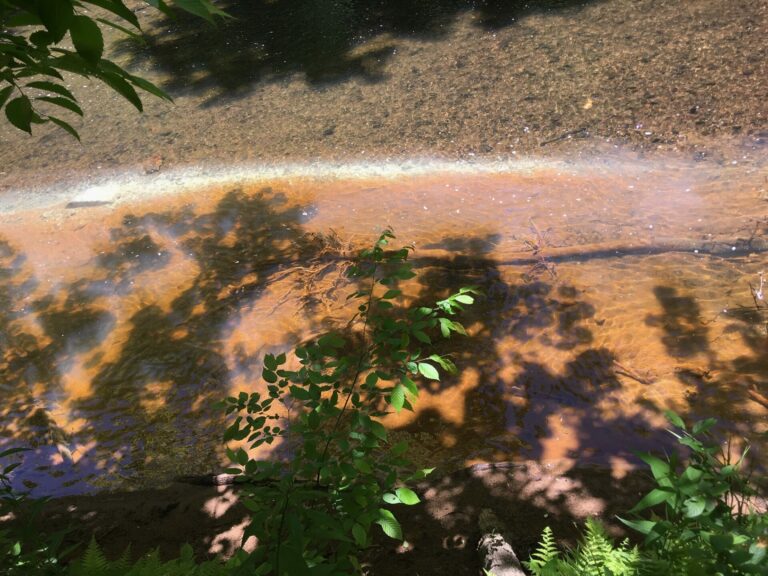
In June, MWA received several complaints of visibly polluted water in Indian Creek, seen approximately from our Sagamore AMD treatment system downstream all the way past Resh Park. Many wondered if the treatment system was failing, but that is not the case. The Sagamore AMD treatment system is functioning properly! The source of this horrible contamination is actually a separate issue, one we like to call the ‘rogue discharge.’
You may have noticed this orange seep (pictured right) along the side of the Indian Creek Valley Trail, just before the Sagamore treatment system. This is the rogue discharge. This particularly nasty AMD originates underground, seeps out of the hillside there, then drains into a small channel and enters Indian Creek upstream of the treatment system (without going through any treatment). The rogue discharge is always flowing, but the majority of the time it is at a low rate. Every so often, however, this AMD source experiences a major flushing event and the rogue discharge runs rampant.
That is exactly what occurred this June. The rogue discharge was flowing at a high rate, carrying large amounts of metals into Indian Creek.

MWA collected several water samples on June 8th to quantify the impact of this discharge on Indian Creek. We found that the discharge itself was highly acidic and contained astronomical concentrations of salts and metals, including 3090 mg/L sulfate, 581 mg/L iron, and 218 mg/L aluminum. Furthermore, we found that the discharge was having a detrimental effect on Indian Creek (see table below). Aluminum and iron levels were significantly higher and the pH was much lower (more acidic) in Indian Creek below the discharge. Even as far as one mile downstream of the rogue discharge, iron levels were still elevated at 2.66 mg/L.

Even more compelling than hard numbers is a visit to the site. The stream bottom is coated with inches of bluish/white and red sediments from the metals, as far as one mile downstream. This suffocates aquatic macroinvertebrates and destroys habitat for fish and other creatures.
This bleak site was also the exact location of MWA’s hellbender skeleton discovery (What’s Happening with Hellbenders?). One must wonder if this rogue discharge is damaging the habitat of these unique creatures, or even killing them.

So why hasn’t MWA fixed it yet? Can’t we just channel it into the existing treatment system?
Unfortunately, it isn’t that simple.
Each treatment system is designed to treat a unique volume of AMD as well as specific concentrations of the different metals. The Sagamore system simply was not designed to treat this additional source of AMD. This is partially because the Sagamore system was only designed to treat iron and the Rogue Discharge contains high levels of aluminum.
Another issue with this discharge is that it is very inconsistent in flow and metal concentrations. It isn’t always this bad. Since MWA began routinely sampling this discharge in 2014, our data shows 7 high-metal flushing events. These are events where the level of aluminum and/or iron in the discharge exceeded 50 mg/L. So, a major event like this usually occurs each year, sometimes lasting months at a time (such as in 2017).
MWA is currently working to prove to the DEP that this discharge is having a detrimental effect on Indian Creek. Once we convince the DEP that this discharge must be remediated, we can work with them to find a permanent solution to this nasty source of pollution.
If you see pollution in the stream, please notify MWA at (724)455- 4200 as well as the Department of Environmental Protection.

